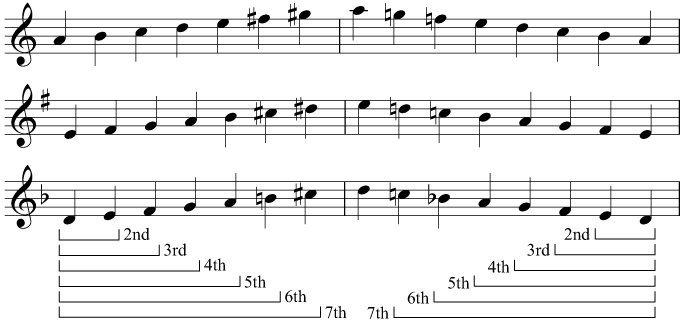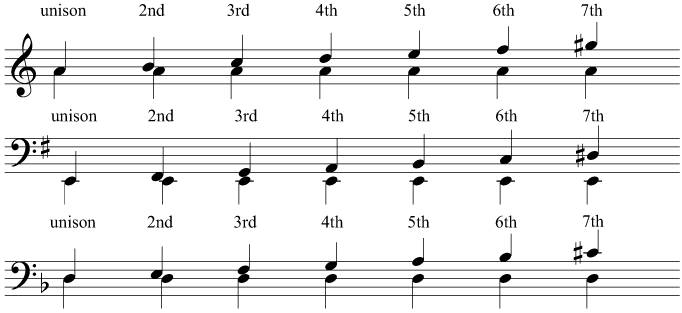Intervals level 2
In this guide...
Key terms:
Subscription required!
To view the complete study guide, you will need a valid subscription. Why not subscribe now?
Already have a subscription? Make sure you login first!
Introduction
We have already looked at the concept of intervals, and now it's time to take the idea a little further...
Interval number
Previously, we looked at the number of an interval; specifically, the distance of one note above the first note in a scale.
We constructed intervals above the note C and described them as a 2nd, 3rd, 4th, 5th, 6th, or 7th. We also learned that the "8th" is known as the octave and that the "1st" is known as the unison.
 The intervals between C and the natural notes above
The intervals between C and the natural notes aboveThe tonic
What we have in fact done here is name the possible intervals above the tonic - the first note - of the scale of C major.
So, we can say that "G is an interval of a 5th above the tonic in C major", or that "D is an interval of a 2nd above the tonic in C major".
The tonic is the note after which the scale is named, and is the first note of the scale. So, the tonic of C major is C, the tonic of D major is D, and so on.
This is also true of minor keys; the tonic of A minor is A, and the tonic of E minor is E, and so on.
Intervals in major keys
Now that you've seen how we describe intervals above the tonic in C major, let's have a look at the same intervals in some other keys. The principle is exactly the same!
Intervals above the tonic in A major:
 Intervals above the tonic in A major
Intervals above the tonic in A majorIntervals above the tonic in B flat major:
 Intervals above the tonic in B flat major
Intervals above the tonic in B flat majorIntervals above the tonic in E flat major:
 Intervals above the tonic in E flat major
Intervals above the tonic in E flat majorMelodic intervals
As you can see from the above examples of intervals in major scales, in comparison to the C major example, we can use the same system to describe the interval between a pair of notes that are stacked together (as in the three examples above), as well as notes that are neighbouring (as in the first example, in C major).
- Intervals between pairs of notes that are neighbouring are called melodic intervals.
- Intervals between pairs of notes that are stacked together are called harmonic intervals.
Here is an example showing several melodic intervals.
 Several melodic intervals in E flat major
Several melodic intervals in E flat majorCan you name them all? The key is E flat major.
Harmonic intervals
Harmonic intervals work in just the same way as if the stacked pair of notes were neighbouring notes. However there is a small trap for the unwary!
Always make sure to count up from the lower of the two notes, and not down from the upper note!
In the following example in B flat major, if we count up from the lower note, we (correctly) conclude that the interval is a 5th: B flat, C, D, E flat, F.
 A harmonic interval in B flat major
A harmonic interval in B flat majorHowever, if we start counting at the F, we get a different (and wrong) answer: F, G, A, B flat, i.e. a 4th.
Intervals in minor keys
In minor keys, melodic and harmonic intervals are described in just the same way. However you will have noticed the similarity between the terms used - there are melodic and harmonic minor scales, and there are melodic and harmonic intervals.
This is no coincidence!
The melodic minor scale is derived from melody in a minor key, which consists of a sequence of neighbouring notes: i.e., melodic intervals.
The harmonic minor scale, by contrast, is an adapted version of the minor scale for use in harmony, i.e. notes stacked together to form chords and harmonic intervals.
Here are the intervals above the tonic in A minor, E minor, and D minor, for the melodic minor scale:
 Melodic intervals above the tonic in A minor, E minor, and D minor
Melodic intervals above the tonic in A minor, E minor, and D minorAnd here are the intervals above the tonic in the same keys, for the harmonic minor scale:
 Harmonic intervals above the tonic in A minor, E minor, and D minor
Harmonic intervals above the tonic in A minor, E minor, and D minorRead more...
With a subscription to Clements Theory you'll be able to read this and dozens of other study guides, along with thousands of practice questions and more! Why not subscribe now?
Revision
Are you sure you've understood everything in this study guide? Why not try the following practice questions, just to be sure!